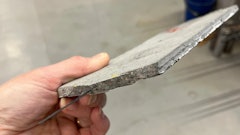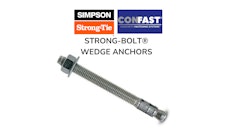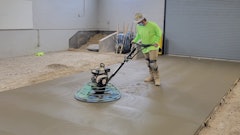1. Select the right formwork. Formwork, the temporary or permanent molds used to hold wet concrete until it sets, is a crucial element in concrete construction. The selection of formwork greatly affects the schedule, labor requirements, quality and total cost of a project. Because conditions vary for each individual project, there is no simple formula for choosing the right formwork supplier or system. Formwork typically accounts for 40-to-60-percent of the total cost of a building’s structural concrete frame. For concrete walls, the cost can be in the 50-to-60-percent range. These percentages include the cost of material and labor, with the largest cost for labor. It is important to analyze labor costs thoroughly, as this is the bigger number and reducing this number will have a much greater impact on bottom-line costs.
To help determine the most efficient solution for a project, a contractor will evaluate several forming systems. Simply stated, a contractor has two choices: an inexpensive forming material that is labor-intensive or a forming system that while costing more, provides high productivity, built-in safety features and is more labor efficient. Other factors the contractor will evaluate when choosing a formwork system include:
- Is the material you require readily available? Does the supplier manufacture the material or do they purchase it from another company?
- Can the formwork supplier pre-assemble some or all of the formwork prior to delivery? This can reduce rental cost, save labor requirements and minimize assembly area requirements.
- Does the supplier provide on-site field service to train and reduce the learning curve of the formwork crew?
- How safe is the system to install, use and dismantle? Can the forms easily be climbed and are tie-off points built into the system where required?
- What experience does the firm have with your type of project?
- Does the supplier offer engineering services? Will the supplier provide formwork assembly drawings specifically for the project or only provide general drawings of the system?
2. Get involved early. Contact formwork suppliers at the very early design stage of the project. This can allow for as much information as possible to be incorporated into the bid documents, which will provide a more accurate cost to the owner. Formwork suppliers can advise on sizing structural concrete members to meet standard form dimensions. And, because major form suppliers typically are involved in a large number of projects in a wide variety of construction markets, they can draw upon their resources to suggest formwork means and methods. Also of importance is to ask concrete forming contractors to be involved early in the design stage of the structure. They are ultimately the people who will be physically building the structure and can provide a tremendous amount of knowledge as to the most economical means and methods.
3. Know when to purchase and when to rent. Another consideration is whether to purchase or rent a system. This decision should be based on the duration of the project and the overall strategy of the company. Typically, if a form system has to be rented for more than 8 to 10-months, purchasing the system might be more economical. However, along with the purchase of a system, there are additional costs such as maintenance and storage. Some formwork companies, however, offer services for customers who purchase their equipment. The quality of the product also must be considered in the decision-making process. Steel-framed wall formwork with standard plywood facing will require more maintenance and repair throughout the life of the form than hot-dipped galvanized steel frames with specially manufactured plywood designed for longer life.
4. Ensure proper access. Proper access is a really important component of formwork use at a worksite as it affects the schedule, budget and safety. Workers must be able to get to the workplace using safe horizontal and vertical access routes. Ladder systems, such as Doka’s Ladder System XS, designed as integral parts of the overall formwork system allow safe access to various points on the formwork.
5. Make fall protection the top priority. At construction sites, falls are one of the top killers in the industry every year and therefore, fall protection is a major safety concern. For a construction worker, “feeling” safe is as important as actually being safe. It is important for productivity and peace-of-mind that a worker has a feeling of security as they move about the formwork structure. A worker will perform his/her duties much more productively if they are comfortable with the structure under their feet. If you are working on top of something that feels rickety, you don’t feel as confident and that can result in a loss of productivity. You want your formwork structure to be outfitted with equipment that meets OSHA requirements for fall protection. Further, a worker needs a safe, easy way to climb from one area to the next, so it is important to have proper ladders installed for easy, safe access from Point A to Point B on the formwork. On platforms where people will be working, install secure guardrails to protect workers from falls. One recent innovation that is improving fall protection procedures on high-rise structures is protection screens. They fully enclose a building’s slab edge, providing a completely contained safe and more productive working environment. These systems anchor to a slab edge around the perimeter of the building. Perimeter protections screens, used at the upper floors of high-rise buildings as they are erected, provide protection from wind, weather and the fear of falling. Doka’s Xclimb 60 Protection Screen provides protection for the working floor and up to three floors below. Other safety precaution ideas include good guardrails and toe boards, and good, solid anchorages where workers can tie-off using their own personal fall arrest systems.
6. Ensure accurate handling and proper assembly. One of the common mistakes that contractors make at a worksite is not following the engineering drawings for assembling and setting-up the formwork. And, not following set-up instructions letter-by-letter can lead to accidents. Trying to cut corners to save set-up time could result in unsafe working conditions and unnecessary downtime. When setting-up and dismantling a formwork structure, follow instructions carefully to ensure safety. Ties, installed properly, will hold the formwork firmly in place as the concrete is poured. The formwork must be properly supported before removal of the ties and the formwork is removed from the set concrete. As an example, Doka’s series of work platforms feature the “Xsafe” system that provides complete, all-around safety before a worker steps onto the platform. The platforms offer extra-safety precautions at the work site through integrated, telescoping ladders, auto-closing manhole lids, and side- and end-guards that integrated into the platform. Another job site innovation that reduces jobsite crane time and formwork labor requirements is formwork lifting elevators that mount to the exterior of a building, allowing all formwork to be cycled from floor to floor without the need for a crane. These table lifting systems are used in conjunction with the smaller table method and also allow for other construction material including handset shoring, vertical formwork and reshores from below to cycle from floor to floor with the need for a crane.
7. Don’t overlook proper formwork ties. With formwork, it is necessary to have the proper ties in place to secure the formwork. Having the proper ties in place and not exceeding the maximum pour pressure as per the design not only guarantees safety, but also will ensure the work is correctly done. For example, if you pour the concrete in too fast and the ties are not strong enough, it creates excess pressure on the forms. The ties can fail and the formwork can move, creating an unsafe condition and work that must be redone.
8. Select the optimal assembly method for your project. Having the formwork pre-assembled at the supplier’s shop not only can save you time in the field, but it also provides many safety advantages. As opposed to the often crowded, cluttered construction site, a shop will have clean, smooth, level areas for building the formwork. This allows the formwork to be more accurately assembled, more solidly built, and be aligned better– important aspects for safe construction and use. Pre-assembly at the shop also gives the supplier access to all the safety devices necessary for the formwork structure (i.e., guardrails, trap doors, etc.) and ensures that they will be properly installed. A contractor should expect the formwork supplier to have all necessary safety equipment included in the system design and in the bid.
9. Safety first. Every worker at construction site knows about safe practices. Union craftspeople learn safe practices during their apprenticeship, and several trade organizations promote the safe and proper use of forming and shoring equipment. However, while safety is never a simple matter, if safety equipment features are easy to use then workers will use them. For example, the only tool needed by a worker in the field for most of Doka’s formwork equipment is a hammer for safe assembly. The purpose of safe practices is so that all workers have a common level of knowledge and that they will all do things the same safe way. If everyone at a construction site follows the same set of safety rules, then a worker on one side of a formwork structure can be confident that a worker on the other side is doing the same thing. For a contractor, enforcing safety at a worksite is the most crucial aspect of getting a job done. With everyone following safe practices, not only will there be fewer accidents (or none at all) but also benefits in increased productivity and efficiency.
10. Training. Formwork technology is constantly changing and you should take advantage of the training now being offered on the proper and safe utilization of forming equipment by the equipment suppliers. Doka offers training sessions for all of their products which is a mixture of classroom and hands on learning. An excellent way to boost your field forces productivity is to have them attend these training sessions.
About DOKA
With 50 years experience in formwork engineering, Doka serves customers in more than 65 countries and has participated in construction of some of the world’s best known structures including the world’s tallest skyscraper (Burj Dubai), the Hoover Dam Bypass bridge, along with many other projects of all sizes. From wall and slab formwork systems to automatic climbing technology and superior safety solutions, Doka can deliver any type of formwork needed for residential, industrial, commercial, transportation, infrastructure as well as stadium and sports arena projects. For more information about how Doka's safe, fast and efficient solutions can aid in your next project, please visit www.dokausa.com , or call 877-DOKA-USA.




























